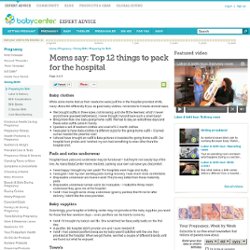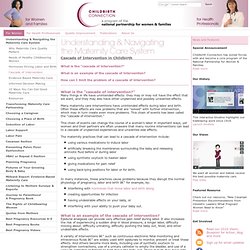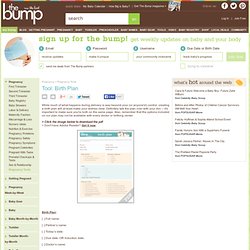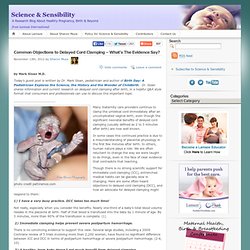

National Birth Statistics in the U.S. Too much unnecessary routine medical intervention in the pregnancy and birth process is putting babies and mothers at risk for harm of all kinds.

In the United States... 30.2% of all babies are born via cesarean surgery Some local Chicago hospitals are at 50%! Ask before you choose your practitioner about their practice and hospital rates. Pregnant? Watch out for unnecessary c-sections and other questionable medical procedures. Pregnant women often undergo medical procedures and invasive interventions, including induced labors and cesarean sections, without fully understanding the risks or being involved in making decisions about their care.

Those are some of the findings of a major new survey to be released on Thursday of 2,400 women who recently had babies. The survey, conducted by Childbirth Connection, a nonprofit organization that focuses on maternity care, identified numerous areas where care for pregnant women often fails to follow established guidelines. Many of the concerns mirror those we previously reported on in our story What To Reject When You're Expecting. "Our survey suggests that pregnant women need to take a more active role to make sure they get the the care that is best for themselves and their babies," says Maureen Corry, M.P.H., executive director of Childbirth Connection. Moms say: Top 12 things to pack for the hospital. Page 3 of 3 Baby clothes While some moms told us their newborns were just fine in the hospital-provided shirts, many others felt differently.

If you do pack baby clothes, remember to include several sizes. We brought outfits in three sizes, not knowing, and she fit the teeniest, which I never would have guessed beforehand. I never thought I would have such a small baby! Pads and extra underwear Hospital-issue pads and underwear may be functional – but they're not exactly top of the line. I was happy I brought my own pads! Baby supplies Surprisingly, your hospital or birthing center may not provide all the baby supplies you need for those first few newborn days – even pacifiers can be hard to come by.
I wish I'd brought my baby's nail file. Towels Bringing your own towel means you have to lug it home again, but many moms felt it was worth it. Cascade of Intervention in Childbirth. What is the "cascade of intervention?

" What is an example of the cascade of intervention? How can I limit the problem of a cascade of intervention? What is the "cascade of intervention? " Many things in life have unintended effects: they may or may not have the effect that we want, and they may also have other unplanned and possibly unwanted effects. Many maternity care interventions have unintended effects during labor and birth. This chain of events can change the course of a woman's labor in important ways, yet women and their partners are often unaware that many routine interventions can lead to a cascade of unplanned experiences and unwanted side effects. The maternity practices that can lead to a cascade of intervention include: The Skeptical OB.
There seems to be a great deal of confusion among natural childbirth and homebirth advocates about the nature and treatment of vaginal tears.

All vaginal tears are not alike. The decision on whether they should be repaired, how they should be repaired and the consequences of not repairing them depend completely on the type of tear. Unfortunately, the need for repair is negatively correlated with the ability of a midwife to repair it. In other words, homebirth midwives know how to repair only minimal tears that would probably heal without repair. Most midwives, including certified nurse midwives, do not know how the to repair the tears that are most critical to repair. Most tears occur downward into the area between the vagina and rectum known as the perineum. The illustration below portrays the normal perineal anatomy. Tearing during childbirth: Can you prevent it? Pregnancy and you blog We gather many souvenirs from childbirth.

Some, like your new baby, are wonderful. Others, such as a sore bottom, are not. For some women, it goes beyond just a sore bottom. If you have extensive vaginal tearing or an incision made in your perineum (episiotomy), the healing process can feel like hell on earth. Whether you're about to deliver for the first time or you're pregnant again, you might wonder: Is there anything you can do to help prevent tearing during childbirth? Stay healthy. Discuss the topic with your health care provider, too.
Effect of timing of umbilical cord clamping of term infants on mother and baby outcomes. Tool: Birth Plan - Pregnancy - Pregnancy Tools. While much of what happens during delivery is way beyond your (or anyone's!)

Control, creating a birth plan will at least make your wishes clear. Definitely talk the plan over with your doc -- it's important to make sure you're both on the same page. Also, remember that the options included on our plan may not be available with every doctor or birthing center. > Click the image below to download the pdf. > Don't have Adobe Reader?
Common Objections to Delayed Cord Clamping – What’s The Evidence Say? By Mark Sloan M.D.

Today’s guest post is written by Dr. Mark Sloan, pediatrician and author of Birth Day: A Pediatrician Explores the Science, the History and the Wonder of Childbirth. Dr. Sloan shares information and current research on delayed cord clamping after birth, in a helpful Q&A style format that consumers and professionals can use to discuss this important topic. photo credit pattiramos.com Many maternity care providers continue to clamp the umbilical cord immediately after an uncomplicated vaginal birth, even though the significant neonatal benefits of delayed cord clamping (usually defined as 2 to 3 minutes after birth) are now well known.
In some cases this continued practice is due to a misunderstanding of placental physiology in the first few minutes after birth. Though there is no strong scientific support for immediate cord clamping (ICC), entrenched medical habits can be glacially slow in changing.